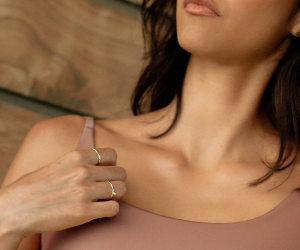By now you might be feeling as confident as ever and looking as gorgeous as always. The best part of this phase is arguably getting to buy all the pretty swimsuits and tops you left in the cart of your favorite online stores.
You most likely have already experienced a lot of changes since your surgery, but there are a couple of things you should consider regarding your implants for the next few months. For example, while your breasts are healing it’s important that your surgeon shows you where your breast tissue end and the implant begins. This will help you distinguish between a lump or irregularity in your own tissue, and the breast implant itself so you can perform your monthly breast exam, which leads us to our first point.
How to perform a breast self exam with implants:
Although the objective is the same, performing a breast self-exam with implants does require a few different techniques. Laying down flat allows the breast tissue to thin and spread over the chest wall in this position, making it easier to feel irregularities and to feel the difference between the breast implant and breast tissue. When you perform the exam, use three fingers and examine the entire breast with slow, circular motions. Press lightly but firmly under the edges of the implants to examine the breast tissue closest to your ribcage. When you stand up, check the placement of the nipples and the appearance of the breasts both with your hands above your head and by your side. This will help you detect changes in the breast and it can also help you determine if there are issues with the breast implants (deflating, puckering, etc.). If you do notice any lumps or irregularities, be sure your doctor and mammogram technician know about your implants when you go in to have them examined. This will help the doctor avoid damaging the implants during a biopsy or a mammogram.
This breast self-examination should be performed every month, beginning at the age of 20. Try to schedule the exam for a few days after your period, so your breasts wont be swollen or painful to the touch. Do the exam at the same time each month so regular breast changes that occur during the menstrual cycle don’t interfere with the examination. Follow our step by step video here for more guidance:
How can I choose the right bra size after my recovery?
The results from breast augmentation tend to come in gradually, which means that the bra size that fits you best a month after surgery will probably not be the same bra size you’re wearing 3 months afterwards. For that reason, you might want to invest in bras slowly. If you’re not sure how to measure your breasts to figure out the right bra size, and you can’t get help from a professional at a department or lingerie store, the process is relatively simple. First, measure beneath your breasts, around the torso to get your band size. Add 5 inches to this number if you get an odd number, or 4 inches if you get an even number. For example, if your lower chest measures 29 or 30 inches, you wear a band size 34. It’s likely that this number is the same now as it was before your surgery. To figure out your cup size, measure around the fullest part of the breasts. Subtract that number from your band size to determine which cup you are. If the difference is three inches, you wear a C cup. If it’s 4 inches, you wear a D cup, and so on.
Dressing after your breast augmentation procedure:
Shopping is always fun, but now it will be even better. One of the main things you have to keep in mind before shopping after your breast augmentation is that it can be difficult to figure out the sizing of items such as dresses and jumpsuits. If your breasts are much larger than before, you might find that your breasts require a bigger dress size than the rest of your body. A good way to accommodate this is to shop for separates: tops, skirts, and pants, for example, so you can mix and match sizes that will flatter you and make you feel beautiful but most importantly, comfortable.
Once you’ve renewed your new wardrobe with super tops and beautiful dresses, add some accessories to the mix. If you like to show off your new shape every once in a while, you might consider long or layered necklaces that drape against the chest, or something bold that brings attention to your neckline, which will be enhanced by your new bust. If business suits are part of your wardrobe, consider placing a stunning pin on the lapel slightly above the bust line or a little scarf tied around your neck. Play with accessories to draw attention to the general area of the bust without focusing specifically on the cleavage or breasts themselves. Accessories are a fun way to play up your style and make a bold statement.
Staying connected with the community:
Last but not least, make sure to follow us on all our social media channels to meet other girls, learn about their experiences, culture and lifestyle. You can also reach out to us through messages to give us updates on your journey, we love learning more about our girls!
Instagram: @motivaimplants
Facebook: Motiva Implants
YouTube: Motiva Implants

